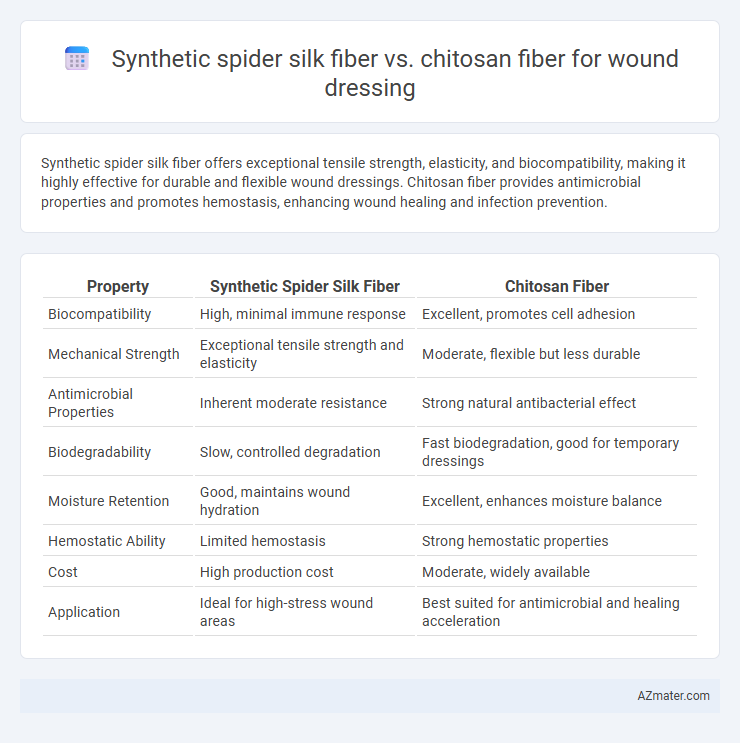Synthetic spider silk fiber offers exceptional tensile strength, elasticity, and biocompatibility, making it highly effective for durable and flexible wound dressings. Chitosan fiber provides antimicrobial properties and promotes hemostasis, enhancing wound healing and infection prevention.
Table of Comparison
| Property | Synthetic Spider Silk Fiber | Chitosan Fiber |
|---|---|---|
| Biocompatibility | High, minimal immune response | Excellent, promotes cell adhesion |
| Mechanical Strength | Exceptional tensile strength and elasticity | Moderate, flexible but less durable |
| Antimicrobial Properties | Inherent moderate resistance | Strong natural antibacterial effect |
| Biodegradability | Slow, controlled degradation | Fast biodegradation, good for temporary dressings |
| Moisture Retention | Good, maintains wound hydration | Excellent, enhances moisture balance |
| Hemostatic Ability | Limited hemostasis | Strong hemostatic properties |
| Cost | High production cost | Moderate, widely available |
| Application | Ideal for high-stress wound areas | Best suited for antimicrobial and healing acceleration |
Introduction to Advanced Wound Dressing Materials
Synthetic spider silk fiber exhibits exceptional tensile strength, elasticity, and biocompatibility, making it a promising material for advanced wound dressings that promote tissue regeneration and reduce infection risk. Chitosan fiber, derived from crustacean shells, offers natural antimicrobial properties and fosters hemostasis, enhancing wound healing through its biodegradability and ability to support cellular adhesion. Both fibers represent significant advancements in wound care materials, integrating mechanical performance with biological functionality to improve patient outcomes.
Overview of Synthetic Spider Silk Fiber
Synthetic spider silk fiber exhibits exceptional biocompatibility, remarkable tensile strength, and elasticity, making it highly suitable for advanced wound dressing applications. Engineered through recombinant DNA technology, this fiber mimics the natural properties of spider silk, promoting cell proliferation and accelerated tissue regeneration. Its biodegradability and resistance to bacterial infection further enhance its effectiveness in protecting wounds during the healing process.
Key Properties of Chitosan Fiber
Chitosan fiber exhibits excellent biocompatibility, biodegradability, and antimicrobial properties, making it highly effective for wound dressing applications. Its ability to maintain a moist environment promotes faster healing while preventing bacterial infections. Compared to synthetic spider silk fiber, chitosan's natural origin and inherent bioactivity enhance tissue regeneration and reduce inflammation in wound care.
Biocompatibility: Spider Silk vs Chitosan in Wound Healing
Synthetic spider silk fiber exhibits exceptional biocompatibility due to its protein-based composition closely mimicking natural extracellular matrix, promoting cell adhesion and proliferation in wound healing. Chitosan fiber, derived from chitin in crustacean shells, offers inherent antimicrobial properties and supports hemostasis but may trigger mild inflammatory responses depending on its degree of deacetylation and molecular weight. Comparative studies reveal that synthetic spider silk fibers provide superior tissue integration and reduced immunogenicity, making them highly effective for advanced wound dressings.
Mechanical Strength and Durability Comparison
Synthetic spider silk fiber exhibits superior mechanical strength and elasticity compared to chitosan fiber, making it highly effective for wound dressings requiring high tensile strength and flexibility. The durability of synthetic spider silk surpasses that of chitosan fiber, providing extended wound support and resilience against wear and tear in dynamic environments. Chitosan fiber, while biodegradable and possessing antimicrobial properties, generally lacks the mechanical robustness needed for durable wound dressing applications.
Antimicrobial Performance Assessment
Synthetic spider silk fiber exhibits superior antimicrobial properties compared to chitosan fiber in wound dressing applications, effectively inhibiting the growth of pathogenic bacteria such as Staphylococcus aureus and Escherichia coli. The protein structure of synthetic spider silk enhances biocompatibility and promotes faster wound healing while maintaining moisture balance. Chitosan fibers demonstrate moderate antimicrobial activity but may be less effective in sustained pathogen control due to variability in molecular weight and degree of deacetylation.
Moisture Retention and Breathability Analysis
Synthetic spider silk fiber exhibits superior moisture retention due to its nanoscale protein structure that mimics natural spider silk's hygroscopic properties, enabling a balanced microenvironment for wound healing. In contrast, chitosan fiber offers excellent breathability through its porous structure, facilitating effective oxygen exchange while maintaining moderate moisture retention. Combining synthetic spider silk's moisture management with chitosan's breathability can optimize wound dressing performance by preventing maceration and promoting faster tissue regeneration.
Biodegradability and Environmental Impact
Synthetic spider silk fiber demonstrates excellent biodegradability, breaking down into non-toxic byproducts that minimize environmental impact during wound dressing disposal. Chitosan fiber, derived from natural shellfish exoskeletons, also decomposes efficiently and promotes eco-friendly waste management through its marine-origin biopolymer structure. Both materials support sustainable medical applications, but synthetic spider silk offers a cleaner production process with fewer ecological pollutants compared to chitosan extraction.
Clinical Applications and Effectiveness
Synthetic spider silk fiber demonstrates exceptional biocompatibility, mechanical strength, and elasticity, making it highly effective for wound dressing by promoting tissue regeneration and reducing infection risk in clinical applications. Chitosan fiber exhibits notable antimicrobial properties and accelerates hemostasis, enhancing wound healing through its biodegradability and ability to maintain a moist environment conducive to cell proliferation. Comparative studies reveal synthetic spider silk provides superior tensile strength and durability, while chitosan excels in antibacterial activity, suggesting potential synergistic use in advanced wound care therapies.
Future Perspectives in Wound Dressing Research
Synthetic spider silk fiber offers exceptional tensile strength, biocompatibility, and tunable biodegradability, making it a promising candidate for advanced wound dressings that promote faster healing and reduce scar formation. Chitosan fiber demonstrates excellent antibacterial properties, hemostatic capabilities, and biocompatibility, supporting infection control and tissue regeneration in dressing applications. Future research will likely focus on hybrid materials combining synthetic spider silk and chitosan fibers to leverage their complementary properties for multifunctional, smart wound dressings with enhanced therapeutic outcomes.

Infographic: Synthetic spider silk fiber vs Chitosan fiber for Wound dressing
 azmater.com
azmater.com